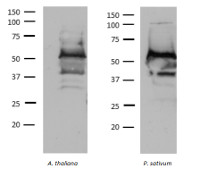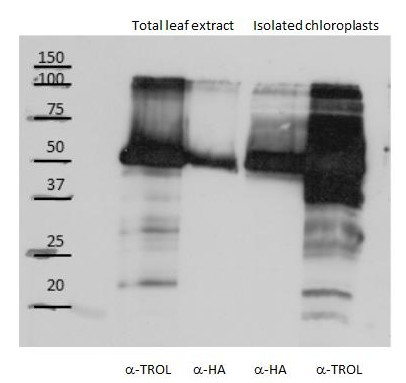1

Anti-TROL | Thylakoid rhodanese-like protein
AS19 4257 | Clonality: Polyclonal | Host: Rabbit | Reactivity: Arabidopsis thaliana, Pisum sativum, Nicotiana tabacum
TROL protein can be used as a chloroplast dual-localization marker: for the thylakoids (the major portion of the protein) and the chloroplastic inner envelope. Since the envelopes make a very small portion of the total membranes, the envelope form of TROL is detectable only when isolated envelopes are applied.
- Product Info
-
Immunogen: KLH-conjugated peptide derived from Arabidopsis thaliana TROL (thylakoid rhodanase-like protein) protein sequence, UniProt: Q9M158, TAIR: AT4G01050 Host: Rabbit Clonality: Polyclonal Purity: Serum Format: Lyophilized Quantity: 50 µl Reconstitution: For reconstitution add 50 µl, of sterile water Storage: Lyophilized antibody can be stored at -20°C. Once reconstituted make aliquots to avoid repeated freeze-thaw cycles. Please remember to spin the tubes briefly prior to opening them to avoid any losses that might occur from material adhering to the cap or sides of the tube. Tested applications: Western blot (WB) Recommended dilution: 1: 1000 - 1 : 3000 (WB) Expected | apparent MW: 55-60 kDa - Reactivity
-
Confirmed reactivity: Arabidopsis thaliana, Nicotiana tabacum, Pisum sativum Predicted reactivity: Brassica rapa, Eutrema salsugineum
Species of your interest not listed? Contact usNot reactive in: No confirmed exceptions from predicted reactivity are currently known - Application Examples
-
Application example

Western blot on Arabidopsis thaliana chloroplasts (2 µg of chlorophyll) using anti-TROL antibodies: Chloroplasts were isolated from 5 week old Arabidopsis thaliana by mixing and filtering through 1-layer Miracloth filter and 4-layers of gauze. Chloroplasts were isolated in 330 mM Sorbitol, 20 mM Tris/HCl pH 8.4, 5 mM EDTA, 10 mM Na2CO3, 0.1% BSA and washed twice in the same buffer and pelleted at 1000g for 5 min at 4°C. Chlorophyll concentration was determined and sample corresponding to 2 μg chlorophyll was separated by 12 % SDS-PAGE. After wet Western transfer for 1h15min on nitrocellulose membrane (0.45μm WC), blot was blocked with 5% milk for 3 times for 10 min at RT with agitation. Blot was incubated in the anti-TROL primary antibody at a dilution of 1:2000 at 4°C/ON with agitation, in PBS buffer containing 1%Tween 20 and 5% milk. The antibody solution was decanted and the blot was rinsed briefly, then washed 3 times for 10 min in the same buffer at RT with agitation. Blot was incubated in anti-rabbit IgG horse radish peroxidase conjugate diluted to 1:50 000 in PBS buffer containing 1%Tween 20 and 5% milk for 1h/RT with agitation. The blot was washed 2 times for 10 min in PBS buffer containing 1% Tween 20 and developed using 1 ml 1.13 mM luminol (Alfa Aesar) solution in 0.1M Tris(HCl) pH 8.6, 100 μl 6.7 mM p-hidroxy coumaric acid (Sigma) in DMSO and 0.3 μl 35% H2O2 (Kemika). ECL results was analysed by 3-minute exposure on X-ray films.
Courtesy of Dr. Lea Vojta and Dr. Hrvoje Fulgosi, Laboratory for Molecular Plant Biology and Biotechnology, Division of Molecular Biology, Institute Ruđer Bošković,Croatia
Western blot on TROL-overexpressing Arabidopsis thaliana line using anti-TROL antibodies: TROL overexpression line was constructed by transformation of knock-out Arabidopsis thaliana plants by plasmid vector pH7WG2.0 containing TROL-HA-FLAG construct. Total leaf extract from Arabidopsis thaliana corresponding to 20 mg of wet leaf tissue and isolated chloroplasts corresponding to 25 µg of chlorophyll, were loaded on 15 % SDS-PAGE. Western transfer was performed for 1 hour at 200 mA (wet blot). Membrane was immunodecorated with anti-TROL (1:2000) and anti-HA (1:1000) primary antibodies overnight at 4°C. As secondary antibody, anti-rabbit IgG-HRP conjugate (1:50000) was used for anti-TROL and anti-rat IgG-HRP conjugate (1:30000) for anti-HA. Detection was performed using ECL and exposure on X-ray film.
Courtesy of Dr. Lea Vojta, Laboratory for Molecular Plant Biology and Biotechnology, Division of Molecular Biology, Institute Ruđer Bošković, Croatia - Additional Information
-
Additional information (application): TROL protein can be used as a chloroplast dual-localization marker: for the thylakoids (the major portion of the protein) and the chloroplastic inner envelope. Since the envelopes make a very small portion of the total membranes, the envelope form of TROL is detectable only when isolated envelopes are applied.
For AgriseraECLBright and Agrisera matching secondary antibodies goat anti-rabbit HRP conjugated, dilution 1: 25 000 1h/RT incubation (AS09 602), anti-TROL antibodies can be used in dilution of 1:3000.
Recommendation: 2 µg chlorophyll/well. With increased protein or chlorophyll load/well background bands may be detected. Check here. - Background
-
Background: TROL (thylakoid rhodanase-like protein) is an integral membrane component associated to the photosynthetic apparatus of higher plants. TROL is involved in the final step of photosynthetic electron transport by binding a key energy-conversion enzyme ferredoxin: NADP+ oxidoreductase (FNR). This interaction enables direct transfer of photosynthetic electrons from iron-sulphur protein ferredoxin at the stromal site of photosystem I to FNR, which then hands over electrons to NADP+. TROL is located in two distinct chloroplast compartments – in the inner envelope of chloroplasts, in its precursor form; and in the thylakoid membranes, where it is processed completely.
Alternative names: Protein THYLAKOID RHODANESE-LIKE1, Sulfurtransferase 4, AtStr4 - Product Citations
-
Selected references: Vojta and Fulgosi (2019). Topology of TROL protein in thylakoid membranes of Arabidopsis thaliana. Physiologia Plantarum, Special Issue on: “Photosynthesis”. DOI: 10.1111/ppl.12927 - Protocols
-
Agrisera Western Blot protocol and video tutorials
Protocols to work with plant and algal protein extracts
Oxygenic photosynthesis poster by prof. Govindjee and Dr. Shevela
Z-scheme of photosynthetic electron transport by prof. Govindjee and Dr. Björn and Dr. Shevela - Reviews:
-
This product doesn't have any reviews.


